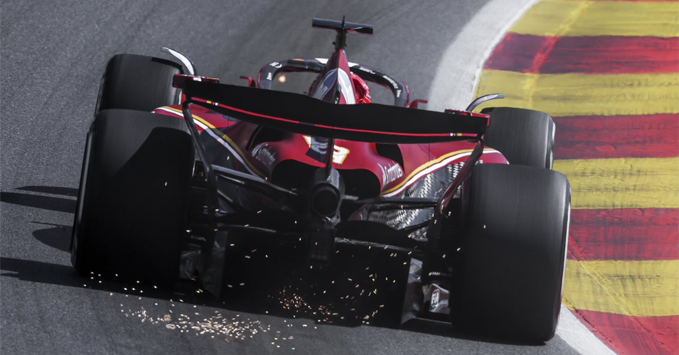Mexican GP: Ferrari pays attention to SF24 hybrid system supporting turbo

10/24/2024 05:19 AM
After the stunning one-two finish in the United States Grand Prix at the Austin circuit with Charles Leclerc and Carlos Sainz, Scuderia Ferrari is now looking forward to the Mexican Grand Prix with great confidence. The Maranello team is working in order to adapt the SF-24 to the characteristics of the circuit dedicated to the Hermanos Rodríguez. The track is located on the plateau of the Mexican capital at an altitude of 2,240 meters above sea level. This means the air is thinner and has less oxygen: for this reason, although maximum speeds that could exceed those of Monza can be reached, it is necessary to approve an aerodynamic package with maximum downforce, similar to the choices made for the Monaco Grand Prix in Monte Carlo.
The less dense air affects not only aerodynamic downforce but also two other aspects of the car: it is necessary to increase the size of the brake cooling ducts and review the behavior of the turbocharging system to compensate with the turbo for a power loss that at certain peaks could reach almost 100 horsepower.
During the race in Texas, a power drop was noted on Carlos Sainz's SF-24 at low revs: the Spaniard, who also smelled fuel, was instructed by the pit wall to adjust the steering wheel-computer in order to change the parameters of the electric power delivery. Ferrari’s electronics engineers had opted for an ERS energy distribution aimed at providing good thrust even in the final part of the straights.
During the race, however, the mode of electric use was changed, focusing on greater hybrid support during acceleration out of corners. Since resources are limited, when the engine was filled more with electric support in traction, energy at the end of the straights was lacking, so both Charles Leclerc and Carlos Sainz had to resort to lift and coast.
It does not seem that the adjustment was necessary to preserve fuel consumption, which is always critical at the 5.513-kilometre Circuit of The Americas in Austin. Observers noted that the Spanish driver was instructed to go slower on the last lap, which was a 1.41.083, two seconds more than the previous lap, raising fears that the Spanish driver might be running out of fuel.
It seems that was not the case, because the conservative choice was made to protect the power unit: since the fantastic one-two finish was secured, it didn't make sense to push until the end, safeguarding the power unit for the next rounds. It is no surprise, then, that Lance Stroll, Alexander Albon, and Valtteri Bottas also did the same, increasing their lap times by a couple of seconds.
In Mexico City, there will not be the Sprint Qualifying format, so the three free practice sessions will return. In fact, the second session on Friday will even be extended by half an hour to give teams time to evaluate the prototype tires that Pirelli has developed for the 2025 Formula 1 championship, with the aim of reducing overheating.
It is likely that we will not see many modifications on the red car, aside from what will be the adjustment of the SF-24 to the characteristics of the track, which requires maximum downforce wings and potential cooling intakes. The first free practice session will essentially be dedicated to finding the best use of the hybrid system supporting the turbo, which in Mexico undergoes heavy strain.
The turbocharging system has to compensate for the thinner air and "spin" more than usual. A good distribution of electric energy can be crucial to prevent putting too much pressure on the turbo, as the lack of oxygen tends to heat the air. The engine usage is not too demanding, as full throttle is applied only 62% of the lap, but the gearbox and the turbo are heavily stressed. It is possible that updates to the floor will be put on hold to make the best use of the available aerodynamic package: having the right traction can be crucial for the final result. Introducing new elements might not provide a clear reading of the data for two such different aspects to analyze.
The very pragmatic approach of the Maranello engineers and technicians is a sign that there are high expectations due to simulations that have provided positive sensations. Ferrari team principal Frederic Vasseur wants to keep everyone grounded: perhaps it is not the time to fire all the shots, preferring instead to optimize choices around an SF-24 single-seater that seems to have overcome the flaws that emerged over the summer.
The post Mexican GP: Ferrari pays attention to SF24 hybrid system supporting turbo appeared first on Scuderia Fans.


